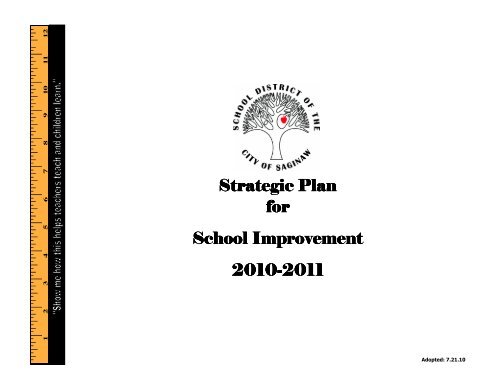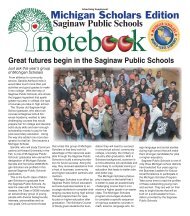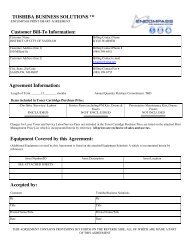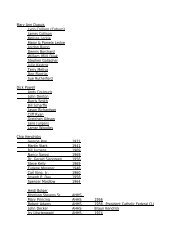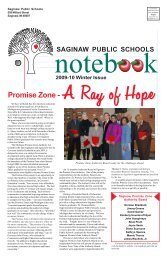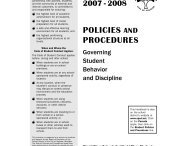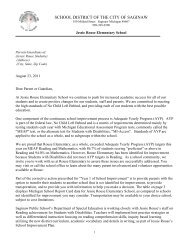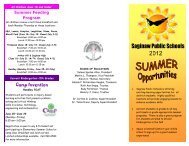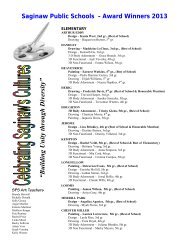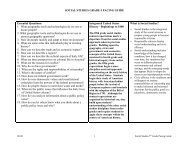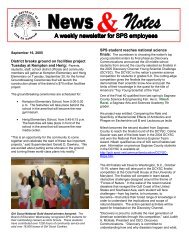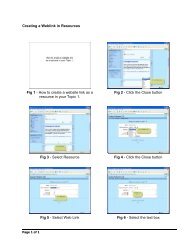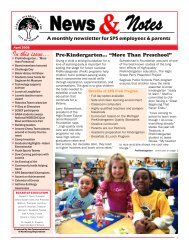Strategic Plan - Saginaw Public Schools
Strategic Plan - Saginaw Public Schools
Strategic Plan - Saginaw Public Schools
You also want an ePaper? Increase the reach of your titles
YUMPU automatically turns print PDFs into web optimized ePapers that Google loves.
“<br />
S<br />
h<br />
o<br />
w<br />
m<br />
e<br />
h<br />
o<br />
w<br />
th<br />
is<br />
h<br />
el<br />
p<br />
s<br />
te<br />
a<br />
c<br />
h<br />
er<br />
s<br />
te<br />
a<br />
c<br />
h<br />
a<br />
n<br />
d<br />
c<br />
hi<br />
ld<br />
re<br />
n<br />
le<br />
ar<br />
n<br />
”<br />
S<br />
<strong>Strategic</strong> <strong>Plan</strong><br />
for<br />
School Improvement<br />
2010-2011<br />
2011<br />
Adopted: 7.21.10
The School District of the City of <strong>Saginaw</strong> would like to thank the following parents, staff and community leaders for their hard work<br />
and dedication in creating this document:<br />
Trisha Baker Jeanine Kowalski Trent Mosley Latoya Summey<br />
Connie Bockelman Glendorah Lawrence Tina Munoz Anne Tapp<br />
Melinda Carroll Karen Lawrence-Webster Kim Newman Ericka Taylor<br />
Debbie Chaddah Doreen Leek Elsa Olvera Victoria Trejo<br />
Stacey Corrigan Terri Lieber Cynthia Pape Janiel vonReichbauer<br />
Dianne Dalton Catherine MacArthur Ted Papesh Jose Valderas<br />
Mary Ann Dupuis Roy Manning Michael Rhoden Kelly Warner<br />
Ernestine Ford Nathaniel McClain Ramont Roberts Lawrence Watson<br />
Kim Hamilton Terrence Metiva Pamela Ross McClain LaVarne White<br />
Lori Hurley Yoneko Miyamoto Rebecca Sanchez Rebecca Wilkins<br />
Jann Kennedy Deborah Monohan Darci Seamon Kristi Weber<br />
Amanda Kitterman-Miller Safiya Mosley Edwin Sprague<br />
Adopted: 7.21.10<br />
2
INTRODUCTION<br />
The School District of the City of <strong>Saginaw</strong> has been involved in strategic planning for school improvement since the late 1980s. The process involves<br />
ongoing commitment and involvement from all segments of our schools and community.<br />
The important part of this plan has been the re-examination and reaffirmation of our direction. Do we understand our stakeholders’ requirements?<br />
Have they changed? Are our Goals aligned with the stakeholders’ requirements? Have we clearly defined how we will measure accomplishment of these<br />
goals? Is our Mission still appropriate? In short, are we still headed in the right direction, with the appropriate goals and measures so we’ll know when<br />
we arrive?<br />
<strong>Saginaw</strong>’s <strong>Strategic</strong> <strong>Plan</strong> answers these and other important questions, and in doing so, shapes the District organization for the next five years and<br />
beyond. The planning and operation of all divisions, departments, buildings, programs and classrooms in the district, must be aligned with this District<br />
<strong>Strategic</strong> <strong>Plan</strong>.<br />
Key elements of the <strong>Strategic</strong> <strong>Plan</strong> include:<br />
Vision -<br />
Core Beliefs –<br />
Mission –<br />
Graduate Standards –<br />
Strategies –<br />
Goals and Measures –<br />
Targets –<br />
what must we do – and do well – to meet and exceed our stakeholders requirements? Why does our organization<br />
exist? Why are we in business?<br />
the heart-and-soul of the organization; what we value.<br />
our commitment to accomplishing the Mission, Vision, and Goals of the District.<br />
what students must know and be able to do when they graduate; the focus of instruction at all grades and levels.<br />
the actions and processes we implement and support district-wide to meet our Goals and achieve our Mission.<br />
what goals, when accomplished, will meet the Mission and Vision of District? What measures will clarify the goals<br />
and monitor progress?<br />
the results we would like to see from one data collection to the next, based on past results and trends.<br />
By itself, the district <strong>Strategic</strong> <strong>Plan</strong> for School Improvement is just that – a plan. It is a direction determined by the district leadership, in response to<br />
listening carefully to stakeholders. The district believes strongly that the processes necessary to achieve the goals are best developed, implemented and<br />
continually improved by those who are closest to the actual work on the system – whether at the division, department, building or classroom level.<br />
The district curriculum is guided by state and national standards and benchmarks and is an integral part of the School District of the City of <strong>Saginaw</strong>’s<br />
<strong>Strategic</strong> <strong>Plan</strong> for School Improvement. As such, it is the focus for School Quality <strong>Plan</strong>s and the basis for instruction and learning at the building level.<br />
The curriculum is defined by grade level benchmarks for each core content area and further by the standards and benchmarks for career and<br />
employability skills. The career and employability skills benchmarks and standards are included throughout the district’s 10 Graduate Standards.<br />
Adopted: 7.21.10<br />
3
The alignment of the district <strong>Strategic</strong> <strong>Plan</strong> for School Improvement and Building School Quality <strong>Plan</strong>s is an essential element of <strong>Saginaw</strong>’s Compact of<br />
Professional Educators.<br />
VISION<br />
Excellence is the direction in which the School District of the City of <strong>Saginaw</strong> will guide students from where they are, provide opportunities to maximize<br />
their potential regardless of socioeconomic status, race, ethnicity, mobility, or family\educational status.<br />
We believe fundamentally that:<br />
CORE BELIEFS<br />
Every student is unique, valuable and capable of learning.<br />
Every student graduates from high school understanding that learning is life-long in order to compete and contribute successfully in a global<br />
society.<br />
The responsibility of education is shared among all members of the community.<br />
Appreciating the diversity of student’s backgrounds, abilities, and interests are integral to the success of each student.<br />
Every family/parent involved in his or her child’s education is an integral part of each student’s success.<br />
MISSION STATEMENT<br />
The School District of the City of <strong>Saginaw</strong>, in partnership with parents, students, businesses and the community, are committed to and responsible for<br />
ensuring:<br />
the highest level of academic achievement and career planning for all students,<br />
the highest performing organizational structure at all levels, and<br />
a safe and effective learning environment for all students.<br />
DISTRICT GOALS<br />
<br />
<br />
<br />
Every student in the School District of the City of <strong>Saginaw</strong>, (SPSD), will demonstrate achievement in all subject areas and exhibit the SPSD<br />
Graduate Standards.<br />
All SPSD schools will meet or exceed the requirements of the Elementary and Secondary Education Act and make Adequate Yearly Progress.<br />
The SPSD will maintain Safe and Effective <strong>Schools</strong>.<br />
Adopted: 7.21.10<br />
4
The SPSD will be a Stable and High Performing Organization.<br />
SPSD will build community, parent and business partnerships to support and enhance student achievement.<br />
GRADUATE STANDARDS<br />
The Graduate Standards of the School District of the City of <strong>Saginaw</strong> are statements of adult roles, skills and knowledge that all students need in order<br />
to be successful in the world after graduation from <strong>Saginaw</strong> <strong>Public</strong> <strong>Schools</strong>. They represent a consensus of the best knowledge and expertise of our<br />
customers, both inside and outside our school system. They come from individuals who live and prosper within our community and the world around<br />
us. These are the areas in which we set the highest expectations. We envision all students achieving the Graduate Standards.<br />
ACADEMIC ACHIEVERS, who:<br />
Demonstrate achievement of academic core curriculum content standards in science, mathematics, language arts, and social studies.<br />
Demonstrate proficiency on MEAP and MME/ACT assessments in science, mathematics, communication arts, and social studies.<br />
Read, write, speak and listen effectively and appropriately in a variety of settings, and for a variety of audiences.<br />
Understand and use basic mathematics skills to reason and communicate mathematically to solve real-world problems.<br />
Make connections between and among subject areas.<br />
Learn and use scientific knowledge and ways of thinking, through the study of the life and physical sciences and technological systems.<br />
Demonstrate effective, responsible citizenship through the study of history, geography, economics, civics, and humanities.<br />
Examine and make career choices and plan educational programs to meet these goals.<br />
SELF-DIRECTED LEARNERS, who:<br />
Do what is needed without being told.<br />
Display persistence.<br />
Recognize learning needs and develop strategies to support lifelong learning.<br />
Maintain regular and timely attendance and participation.<br />
Establish, implement and monitor a career development plan, including academic goals.<br />
COMPLEX THINKERS, who:<br />
Effectively use reasoning strategies in meaningful, age-appropriate situations.<br />
Effectively use a variety of complex reasoning strategies in real-life situations, including:<br />
-- Comparison<br />
-- Classification<br />
-- Analysis<br />
-- Induction<br />
-- Deduction<br />
-- Extending<br />
Adopted: 7.21.10<br />
5
-- Inquiry<br />
-- Evaluation<br />
EFFECTIVE COMMUNICATORS, who:<br />
Understand verbal and nonverbal communication.<br />
Listen to and evaluate the ideas of others.<br />
Select and use appropriate forms of communication to understand, and be understood by, diverse audiences.<br />
Construct and interpret data in written, numerical and graphical form.<br />
Select and use appropriate media for communication.<br />
Read, speak, write and listen with clarity, across the curriculum, for a variety of purposes and audiences.<br />
INDIVIDUAL/GROUP PROBLEM SOLVERS, who:<br />
Use problem-solving strategies, including:<br />
-- Identifying needs and problem solving opportunities for self and others,<br />
-- Relating to the problem solving needs, contexts and viewpoints of different groups,<br />
-- Proposing a range of alternative ideas to solve needs, and using information from a range of sources, describing the strengths and<br />
weaknesses, and the beneficial and detrimental consequences of each idea.<br />
-- <strong>Plan</strong>ning, carrying out, evaluating and modifying as necessary, a selected course of problem solving action.<br />
Continually evaluate solutions against the original need until the group facing the original difficulties is satisfied with the outcome.<br />
STRONG INTERPERSONAL RELATORS, who:<br />
Balance the pursuit of self-interest with respect for the rights of others.<br />
Constructively manage conflict within themselves and between and among others.<br />
Demonstrate respect for cultural, racial, physical and political differences.<br />
COLLABORATIVE WORKERS, who:<br />
Work effectively with others.<br />
Use techniques to achieve agreement within the group.<br />
Work toward group goals.<br />
Monitor and adjust one’s own behavior to accomplish group goals.<br />
Share praise and criticism in a constructive manner.<br />
Recognize differing opinions as a positive force in achieving group goals.<br />
CREATIVE QUALITY PRODUCERS, who:<br />
Exhibit pride and satisfaction in their work.<br />
Generate new ways of viewing a situation outside the boundaries of standard convention.<br />
Adopted: 7.21.10<br />
6
Create quality products, environments for services that achieve their purpose, are appropriate for the intended audience and reflect high<br />
standards.<br />
Set quality standards, aligned with the goals of the organization, by which they evaluate their own work.<br />
Demonstrate innovation in improving products, environments, services or processes of production.<br />
COMMUNITY CONTRIBUTORS, who:<br />
Understand and respect community rules and laws.<br />
Contribute knowledge, time and talents to making their communities better places to live through volunteerism.<br />
HEALTH CONSCIOUS INDIVIDUALS, who:<br />
Handle stress in responsible ways.<br />
Understand and practice proper nutrition.<br />
Avoid substance abuse.<br />
Participate routinely in physical activities.<br />
Practice preventative health care and safety.<br />
Adopted: 7.21.10<br />
7
Priority Goal #1: The District will deliver rigorous, relevant and flexible academic programs that are globally competitive and<br />
cultivate a culture of college bound or post-secondary learners.<br />
Objectives<br />
Person(s)<br />
Accountable<br />
Timeline Resources<br />
Needed<br />
Professional<br />
Development<br />
Needs<br />
Performance Measures/<br />
Evidence<br />
1. The District will use researchbased<br />
instructional practices<br />
for all students in order to<br />
increase the number of<br />
students by 5%, who receive a<br />
“Met” or “Exceeded” score on<br />
MEAP Reading, Writing, Math,<br />
and Science.<br />
Central Office<br />
Instructional<br />
Personnel, Building<br />
Administrators,<br />
Teachers<br />
2010-2011 School<br />
Year<br />
All available general, State,<br />
and Federal<br />
monies/partnerships with<br />
universities and businesses<br />
Data Driven Decision<br />
Making, intervention<br />
strategies,<br />
monitoring/evaluation<br />
systems, collaboration<br />
MEAP, Curriculum Based Measurement, High<br />
School Testlets, ITBS, School Process<br />
Rubrics,(EdYES), Comprehensive Needs<br />
Assessment (CAN)<br />
2. Meet and exceed Michigan<br />
Common Core Standards at<br />
each grade level.<br />
Central Office<br />
Instructional<br />
Personnel, Building<br />
Administrators,<br />
Teachers<br />
2010-2011 School<br />
Year<br />
All available general, State,<br />
and Federal<br />
monies/partnerships with<br />
universities and<br />
businesses, technology for<br />
instructional and<br />
monitoring purposes<br />
Michigan Common Core<br />
Standards Training, Pacing<br />
Guides, intervention<br />
strategies,<br />
monitoring/evaluation<br />
systems, integration of<br />
technology<br />
Grade Level Report Cards, Curriculum Based<br />
Measurement, High School Testlets, student<br />
products, Senior Projects, Portfolios,<br />
Comprehensive Needs Assessments, (CAN)<br />
3. Provide a consistent framework<br />
for reporting data to stakeholders.<br />
Dept. of EQM, Central<br />
Office Instructional<br />
Personnel, Building<br />
Administrators,<br />
Teachers<br />
2010-2011 School<br />
Year<br />
Timelines for assessments<br />
at all levels<br />
Interpreting data<br />
Quarterly reporting, each marking period,<br />
Annual Reports, Report cards, progress<br />
reports, website portal/Skyward<br />
4. The district will evaluate<br />
programs and services each<br />
year for their effectiveness and<br />
relevance.<br />
Dept. of EQM, Central<br />
Office personnel,<br />
consultants, Buildings<br />
Administrators<br />
2010-2011 School<br />
Year<br />
Data, staffing to perform<br />
and interpret, EQM,<br />
consultants<br />
Interpreting data, research<br />
on Best Practices<br />
Reports (surveys, consultants, supplemental<br />
software reports), student achievement data<br />
5. All students will demonstrate<br />
achievement in standards for<br />
career and employability skills<br />
and the district will monitor the<br />
number and percent of<br />
students who are employed<br />
and/or placed into higher<br />
education.<br />
Central Office<br />
Instructional<br />
Personnel, Building<br />
Administrators,<br />
Teachers<br />
2010-2011 School<br />
Year<br />
Follow up surveys,<br />
graduation data, partnerships<br />
with colleges and<br />
universities, Career<br />
Pathways data<br />
Senior projects, graduation data, surveys<br />
Adopted: 7.21.10<br />
8
Priority Goal #1: Continued..,<br />
Objectives<br />
6. Monitor students for academic<br />
and behavioral progress.<br />
Person(s)<br />
Accountable<br />
Central Office<br />
Instructional<br />
Personnel, Dept of<br />
EQM, Building<br />
Administrators,<br />
Teachers<br />
Timeline<br />
2010-2011 School<br />
Year<br />
Resources<br />
Needed<br />
Progress monitoring<br />
systems, intervention plans<br />
and teams<br />
Professional<br />
Development<br />
Needs<br />
MiBlisi Training to include<br />
Response to Intervention<br />
and Positive Behavior<br />
Support, intervention plans<br />
Performance Measures/<br />
Evidence<br />
Curriculum Based Measurement, decrease in<br />
behavioral and academic referrals, decrease<br />
in dropout rate, retention numbers, increase<br />
in graduation rate.<br />
7. The district will employ staff<br />
that meets the definition of<br />
“Highly Qualified” as defined<br />
by the State of Michigan.<br />
8. Site-based management will<br />
ensure that the needs of the<br />
stakeholders are being met<br />
Executive Director of<br />
Human Resources<br />
Central Office<br />
Instructional<br />
Personnel, Building<br />
Administrators,<br />
Teachers, School<br />
Quality Teams,<br />
Parents, University<br />
and business partners<br />
2010-2011 School<br />
Year<br />
2010-2011 School<br />
Year<br />
Federal Funding for<br />
support of any required<br />
courses<br />
Funding to support<br />
training, time allocation for<br />
meetings<br />
Course offerings to<br />
complete or continue HQ<br />
status<br />
Training on grade level<br />
expectations, data<br />
interpretation, School<br />
Quality <strong>Plan</strong>ning, LEA<br />
<strong>Plan</strong>ning, funding<br />
requirements and process<br />
State certifications kept on file and reviewed<br />
yearly.<br />
School Quality <strong>Plan</strong>s, surveys<br />
Adopted: 7.21.10<br />
9
Priority Goal #2: The District will operate and maintain schools of excellence through financial stability and with safety<br />
assurances.<br />
Objectives<br />
1. The district will provide checks<br />
and balances that are transparent<br />
to all stakeholders and<br />
ensure an understanding of<br />
finances and operations.<br />
2. The district will maintain a<br />
balanced budget.<br />
Person(s)<br />
Accountable<br />
Chief Financial<br />
Officer, Finance<br />
Dept., Title I,II,III<br />
31a, Directors, Asst.<br />
Supt for<br />
Teaching/Learning,<br />
Expenditure Review<br />
Comm., Building Adm.<br />
<strong>Saginaw</strong> Board of<br />
Education members<br />
Chief Financial<br />
Officer, Finance<br />
Dept., Title I, II, III,<br />
31a, Directors, Asst.<br />
Supt for Teaching/<br />
Learning, Expenditure<br />
Review Committee,<br />
Building Admn.,<br />
<strong>Saginaw</strong> Board of<br />
Education members<br />
Timeline<br />
2010-2011 School<br />
Year<br />
2010-2011 School<br />
Year<br />
Resources<br />
Needed<br />
Skyward financial system,<br />
monthly reports,<br />
expenditure procedures,<br />
Consolidated Application,<br />
District <strong>Strategic</strong> <strong>Plan</strong><br />
Expenditure review<br />
committee, Consolidated<br />
Application, Finance<br />
Committee, 2010-2011<br />
budget<br />
Professional<br />
Development<br />
Needs<br />
Use of Skyward, reviewing<br />
of reports by building,<br />
procedures and policies<br />
training, Federal and State<br />
programs training<br />
Use of Skyward, reviewing<br />
of reports by building,<br />
procedures and policies<br />
training, Federal and State<br />
programs training<br />
Performance Measures/<br />
Evidence<br />
Balanced budget, procedures for expenditures<br />
followed, expenditure reports tie to<br />
district needs /<strong>Strategic</strong> <strong>Plan</strong> and building<br />
level comprehensive needs assessments.<br />
Balanced budget, procedures for<br />
expenditures followed<br />
3. Over the next year, the district<br />
will work towards stabilizing<br />
student enrollment in order to<br />
plan for a more accurate<br />
budget and stabilize staffing.<br />
All Stakeholders,<br />
school employees,<br />
business, community,<br />
and parents, students<br />
2010-2011 School<br />
Year<br />
A rigorous academic plan<br />
at all grade/skill levels,<br />
student alternative support<br />
systems, <strong>Strategic</strong> <strong>Plan</strong><br />
that provides direction and<br />
consistency, a marketing<br />
plan, data to examine<br />
mobility rates and attrition<br />
School Quality <strong>Plan</strong>ning<br />
sessions to align school<br />
plans to the District,<br />
Common Core Standards<br />
Building plans that align with the district<br />
strategic plan, surveys from all stakeholders,<br />
assessment for academic and community<br />
needs<br />
4. The district will use Federal and<br />
State dollars in conjunction with<br />
the LEA <strong>Plan</strong>ning Cycle and<br />
other grant planning documents,<br />
to increase the amount of<br />
support given to students.<br />
Title I, II, and III,31a<br />
Directors, Chief<br />
Financial Officer,<br />
Finance Dept.,<br />
Building<br />
Adm./Teams/Grants<br />
officer<br />
2010-2011 School<br />
Year<br />
Consolidated Application to<br />
support instruction<br />
State and Federal Program<br />
training, funding request<br />
forms, operations of grant<br />
sources and allocations<br />
Time/service logs, expenditure reports,<br />
Consolidated Application, sign-in sheets,<br />
consultation sessions with building level<br />
teams, Funded Program <strong>Plan</strong>s within the<br />
School Quality <strong>Plan</strong>.<br />
Adopted: 7.21.10<br />
10
Priority Goal #2: Continued..,<br />
Objectives<br />
Person(s)<br />
Accountable<br />
Timeline<br />
Resources<br />
Needed<br />
Professional<br />
Development<br />
Needs<br />
Performance Measures/<br />
Evidence<br />
5. The district will reduce the<br />
amount of Student Code of<br />
Conduct violations by 5% as<br />
outlined in the District Policies<br />
and Procedures Governing<br />
Student Behavior and<br />
Discipline.<br />
All District Staff,<br />
students, parents,<br />
student support<br />
services/hearing<br />
officer<br />
2010-2011 School<br />
Year<br />
Policies and procedures<br />
handbook, Student<br />
database, Social Workers<br />
Positive Behavioral<br />
Training, Intervention<br />
planning, diversity, cultural<br />
norms and sensitivity<br />
training, alternative to<br />
suspension training<br />
SID Report, reductions in suspensions and<br />
Board Level Hearings, Intervention <strong>Plan</strong>s for<br />
staff and students<br />
6. The district will work toward<br />
improving the public’s perception<br />
that the District is a Safe<br />
and Effective Learning Environment.<br />
Chief of Security,<br />
District staff, parents,<br />
students, Director of<br />
Facilities Services<br />
2010-2011 School<br />
Year<br />
Safety and security plans,<br />
security officers, building<br />
plans, district-wide<br />
expectations and follow<br />
through, customer service,<br />
facility reviews, community<br />
input/maintenance and<br />
custodial staff<br />
Carrying out behavioral<br />
expectations, customer<br />
service, relevant<br />
home/school connection<br />
Surveys, number of students attending our<br />
schools, increase in parental involvement,<br />
sign in sheets from trainings, Parent<br />
Involvement data, reduction in complaints,<br />
satisfaction surveys, KEYS Assessment. The<br />
Facilities <strong>Plan</strong> for Improvement is reviewed<br />
yearly. Successful completions and reports<br />
for updating required safety inspections.<br />
7. The district will increase the<br />
average daily attendance rate.<br />
Truancy officers,<br />
building administrators,<br />
student support<br />
services, student<br />
accounting<br />
2010-2011 School<br />
Year<br />
Skyward attendance,<br />
truancy teams<br />
Truancy in-service, the<br />
importance of the educational<br />
process and<br />
attendance.<br />
Attendance data by building and district will<br />
show decrease in truant students and drop<br />
outs.<br />
Adopted: 7.21.10<br />
11
Priority Goal #3:<br />
Objectives<br />
1. Identify and respond to the<br />
needs of all individuals.<br />
The District welcomes and values all of its business and community members and meets their needs in a<br />
timely, respectful, courteous, and proactive manner.<br />
Person(s) Timeline Resources Professional Performance Measures/<br />
Accountable<br />
Needed Development<br />
Evidence<br />
Needs<br />
All District staff,<br />
parents, students,<br />
Business and<br />
Community partners<br />
2010-2011 School<br />
Year<br />
Needs Assessment<br />
Year-long sensitivity training,<br />
EPSTEIN Model<br />
Surveys, reduction of complaints,<br />
maintain/increased enrollment, District<br />
Parent Advisory Team<br />
2. Understand that the work of all<br />
stakeholders adds value to the<br />
organization, improving quality<br />
and productivity and academic<br />
success.<br />
All District staff,<br />
parents, students,<br />
business and<br />
community partners<br />
2010-2011 School<br />
Year<br />
EPSTEIN, research in<br />
involvement, academic<br />
achievement with<br />
correlation data<br />
EPSTEIN Model, Best<br />
Practices training, relevant<br />
parent involvement<br />
Parent workshop participation, District<br />
Parent Advisory Team<br />
3. Engage in Community,<br />
Business/Industry, and Higher<br />
Education partnerships.<br />
All District staff,<br />
parents, students,<br />
Business and<br />
Community partners<br />
2010-2011 School<br />
Year<br />
Current status/baseline<br />
data of partnerships, hold<br />
meetings outside of our<br />
facilities<br />
Business/industrial/community<br />
training offerings<br />
Increase partnerships by 5%<br />
Adopted: 7.21.10<br />
12
STRATEGIES<br />
The Strategies listed below are the District guidelines for action and support. They are organized around four major themes:<br />
The Nature and Organization of Curriculum<br />
The Changing Role of Learners and Professionals<br />
Staff and Organizational Development<br />
Accountability<br />
We believe attention to these four themes will provide an effective and complete foundation for continuous improvement to meet and exceed our<br />
stakeholders’ expectations.<br />
Some strategies are self-explanatory. Others are followed by a series of suggested actions that will give meaning and intent to the strategy.<br />
The Nature and Organization of Curriculum<br />
Strategy<br />
The district perceives the world as a classroom and promotes innovative programs to emphasize the interdependence of global<br />
systems.<br />
Actions<br />
1. Multidisciplinary and interdisciplinary approaches to curriculum are employed.<br />
2. Understanding of the personal ethics and value systems of the world’s cultures are addressed in all content areas.<br />
3. Teaching and learning emphasize the interdependence of world systems (i.e., economical, political, social, cultural, etc.).<br />
4. Curriculum emphasizes a greater understanding of different cultures and an appreciation of diversity in the community.<br />
5. Curriculum increases the understanding that, from preschool through adult education, all human beings are interconnected and interdependent.<br />
Strategy<br />
Values, ethics, and human understanding and appreciation, are integral parts of the curriculum.<br />
Actions<br />
1. Life in the workplace and society is valued.<br />
2. <strong>Schools</strong> exhibit and teach work virtues (punctuality, reliability, work ethic).<br />
3. Responsible family and societal memberships are expected.<br />
4. Employees understand that their work and effort adds value to the organization, improving quality and productivity.<br />
Strategy<br />
District programs and procedures assure that students learn and can apply critical thinking, problem solving and decision making<br />
skills.<br />
Adopted: 7.21.10<br />
13
Actions<br />
1. Individual and group problem solving skills are integral parts of the curriculum, including:<br />
Teamwork<br />
Human relation skills<br />
Cooperation and understanding<br />
Strategy<br />
Project methodologies and themes are used to link academic and career preparation for all students.<br />
Actions<br />
1. Students are exposed to many broad occupational areas.<br />
2. Education partnerships with business, industry, community and higher education through apprenticeships, job shadowing, co-ops, etc., are<br />
established.<br />
3. Business, community, and school advisory committees are in place in each content area.<br />
4. Vocational/Academic Councils are set up among teachers in both areas across high schools.<br />
5. District-wide PK-post-secondary curriculum focuses on student competency in career, personal, and academic planning and decision-making.<br />
6. Teachers receive ongoing professional development on integrating and developing applied curricula.<br />
Strategy<br />
The district will continue to train and implement the middle education.<br />
Actions<br />
1. Middle level education must address the developmental needs of students, ages 11-14.<br />
2. Middle level education can include home base, exploratory classes, integrated curriculum; block scheduling, team teaching, and intra-mural<br />
sports, professional learning communities, and the concepts of Making Middle Grades Work (MMGW).<br />
Strategy<br />
A core curriculum that is developmentally appropriate, both affective and cognitive, articulated at all levels, and based in the core<br />
academic Content Standards and Grade Level Benchmarks, will be in place at all levels, PK-adult. Instruction, assessment and<br />
professional development are tightly aligned with the core curriculum.<br />
Actions<br />
1. A core content area Lead Teacher network is implemented district-wide.<br />
2. Professional development will be determined by identifying needs in School Quality <strong>Plan</strong>s.<br />
3. Pacing guides are used throughout the school year to ensure the implementation of the core content areas.<br />
Strategy<br />
Technology is a supportive element in the K-12 educational curriculum delivery.<br />
Actions<br />
Adopted: 7.21.10<br />
14
1. Students are knowledgeable about the uses of technology in the workplace and life.<br />
2. The District has a technology plan in place that allows for full immersion within the classroom setting to support the content areas<br />
3. Parents have access to student information through the district web portal.<br />
Strategy<br />
The district supports education in the humanities and fine arts and innovative programs integrating such instruction with other areas<br />
of study.<br />
Actions<br />
1. Art, music, and the humanities are valued as real world experience.<br />
Strategy<br />
The district addresses the health needs of the community through curriculum and partnership building.<br />
Actions<br />
1. Physical and health education are integrated within the elementary curriculum.<br />
2. Parenting education and child development are an integral part of the curriculum.<br />
3. District will establish and maintain a Parent Resource Center, and develop partnerships with local health providers to meet the Health needs of<br />
our parents, children and community.<br />
The Changing Roles of Learners and Professionals<br />
Strategy<br />
<strong>Schools</strong> engage in partnerships with community, business, industry, and higher education to facilitate student learning.<br />
Actions<br />
1. Internships with business and industry related to individual career goals are a requirement for graduation.<br />
2. Business and industry are involved in strengthening the connection between education and work.<br />
3. Parents and community members are active participants on building school quality teams.<br />
Strategy<br />
Teachers collaborate with students, other educators, and appropriate resource people to facilitate student learning and self-esteem.<br />
Actions<br />
1. Teachers work in partnerships with students to help students make wise career, personal, and educational choices.<br />
2. Students are given more autonomy and power of choice in determining their educational programs, through individualized educational<br />
development plans and processes.<br />
3. A collaborative decision-making model is encouraged for making teaching and learning decisions.<br />
Strategy<br />
Students with special needs are provided with high quality learning experiences in a variety of appropriate settings.<br />
Adopted: 7.21.10<br />
15
Actions<br />
1. Innovative programs allow special education, compensatory education, and regular education students and teachers to collaborate in the<br />
classroom (Inclusive Education).<br />
2. Programs for students gifted and talented in a variety of areas are offered.<br />
Strategy<br />
Students are actively engaged in seeking knowledge, constructing knowledge, and applying knowledge.<br />
Actions<br />
1. Students are involved in active, experimental, real-world learning.<br />
2. Learning is centered around themes.<br />
3. Students communicate, learn and evaluate their success with real audiences.<br />
Strategy<br />
Students and teachers use appropriate technology as a means of enhancing and enriching instruction.<br />
Actions<br />
1. Technology, first and foremost, is used as a student tool for accessing and using information, learning in all content areas, and communicating<br />
effectively.<br />
2. Media Centers in each school are information centers.<br />
3. Teachers are trained in the use of technology.<br />
Staff and Organizational Development<br />
Strategy<br />
Effective and appropriate professional development is provided as a means of supporting the continuous improvement of student<br />
achievement.<br />
Actions<br />
1. Staff development activities are designed in response to building needs, as identified through the School Quality <strong>Plan</strong> process.<br />
2. Professional development becomes an integral part of all jobs.<br />
3. Professional development is job-embedded and most effective when professionals actively engage in a cycle of continuous improvement<br />
centered on goals in the building, which align with the District goals.<br />
Strategy<br />
The school time is organized and structured flexibly to enhance student learning and teacher collaboration.<br />
Actions<br />
1. Time is allowed for professionals at building and district level for planning.<br />
2. Innovative organizational designs are encouraged in and among schools.<br />
3. Community service is encouraged.<br />
Adopted: 7.21.10<br />
16
4. Non-traditional school organizations are considered.<br />
Strategy<br />
<strong>Schools</strong> serve as community centers to meet the needs of students, parents, staff and community.<br />
Actions<br />
1. Facilities are used for community activities as well as school related after-school activities.<br />
2. Parent University (workshops), are held at each building during the school year.<br />
Strategy<br />
Participatory site-based, building level management is supported and encouraged.<br />
Actions<br />
1. People affected by decisions are involved in those decisions.<br />
2. Necessary information is readily available to decision makers.<br />
3. Decision making levels are clearly defined and implemented district-wide.<br />
4. Maximizing the resources available at levels closest to student learning is a priority – in exchange for improved student performance on district<br />
goals and measures.<br />
5. Freedom to innovate and take risks at levels closest to student learning is encouraged – in exchange for improved student performance on<br />
district goals and measures.<br />
Accountability<br />
Strategy<br />
Student achievement is assessed by means of multiple approaches including performance assessments, objective referenced<br />
measures, norm referenced tests, and portfolio assessments.<br />
Actions<br />
1. Assessment is used to improve student performance and the instructional program.<br />
2. Assessment of learning is continuous.<br />
Strategy<br />
The district regularly uses up-to-date needs assessment and public reporting techniques to remain responsive and accountable to its<br />
constituency.<br />
Actions<br />
1. District implements a web-based and a building-based form for effective parent, student and community to gage their feelings on customer<br />
service.<br />
2. District holds public forums intermittently to gather input and share information as it relates to students, the community, and current educational<br />
initiatives.<br />
Strategy<br />
Adopted: 7.21.10<br />
17
Roles, responsibilities, and accountability are clearly defined for all participants in the educational process.<br />
Actions<br />
1. Teachers involve students in determining their process for learning.<br />
2. Teachers develop self-directed learners through increased opportunities for student self-assessment against success standards.<br />
3. Principals and teachers have the discretion to make more decisions and the flexibility to use resources in productive, innovative ways that<br />
improve learning – in exchange for improved student performance on district goals and measures.<br />
4. Students are actively involved in the learning process.<br />
5. Parents are partners in the learner-teacher-parent team.<br />
6. Parents have access to the support and training required to fulfill an active role in their children’s learning through parent workshops.<br />
EVALUATION<br />
<strong>Strategic</strong> <strong>Plan</strong>ning is an ongoing process. The <strong>Strategic</strong> <strong>Plan</strong> is the most current document stating our design for the future. We expect the <strong>Strategic</strong><br />
<strong>Plan</strong> to change, and have established the <strong>Strategic</strong> <strong>Plan</strong>ning process to accommodate change. The <strong>Plan</strong> will be updated regularly as new information is<br />
known. Annual reviews of progress will be held as an opportunity to address priority planning for the future. Board involvement and approval will be<br />
sought for the ensuing year. Quarterly reports and reviews, which coincide with the District’s marking periods, will be required of those implementing<br />
certain strategies and actions. Discussions and activities would center on student performance results. Measurement data that will be included in such<br />
reports are: number and percentage of students who receive intensive intervention ,referral data, universal screening, academic achievement data for all<br />
core subjects at each grade level. . This cycle of implementation, review and revision will continue to involve all people affected by the plan.<br />
THE FUTURE<br />
We intend that the <strong>Strategic</strong> <strong>Plan</strong> shape and guide the District, realizing that change is the only certainty. The <strong>Plan</strong> will establish and maintain<br />
standards, and most importantly, will define the parameters within which buildings and divisions operate and develop plans. The <strong>Strategic</strong> <strong>Plan</strong> is<br />
purposely written to allow innovation and creativity in accomplishing the District Mission. It recognizes that planning by building personnel are key to<br />
improving student learning.<br />
We expect buildings to use the pathways established in the <strong>Plan</strong> to actively contribute to the achievement of the District’s Beliefs, Goals and Mission. It<br />
is through the building level School Quality <strong>Plan</strong> that many of the dreams expressed in the District <strong>Strategic</strong> <strong>Plan</strong> are transformed into reality for<br />
students. School Quality Teams are guided by the following:<br />
1. School Quality <strong>Plan</strong>s must be consistent with the District <strong>Strategic</strong> <strong>Plan</strong>.<br />
2. School Quality <strong>Plan</strong>s must actively contribute to achieving the Vision, Core Beliefs, Goals and Mission of the District.<br />
3. School Quality <strong>Plan</strong>s must actively contribute to achieving the Vision, Core Beliefs, Goals and Mission of the building.<br />
The District <strong>Strategic</strong> <strong>Plan</strong> has great implications for the central office support role. Research and development will continue to improve the essential<br />
curriculum for all students including integration of academics, the arts, career and technical education, applied learning, and attention to the active,<br />
engaged role of the learner.<br />
Adopted: 7.21.10<br />
18
The <strong>Strategic</strong> <strong>Plan</strong> is a living document. It is ambitious in its scope, but grounded in the reality that much of what we have done in public education has<br />
been good and should not be discarded.<br />
This <strong>Strategic</strong> <strong>Plan</strong> is unique for several important reasons:<br />
1. It allows us to create our preferred future;<br />
2. It is based on a set of well-defined standards and benchmarks, which give us a clear picture of what knowledge, skills, and attitudes our<br />
graduates should possess;<br />
3. It provides a structure for maximum involvement of all stakeholders in the educational process – staff, parents, the community, business and<br />
industry, higher education, and students; and<br />
4. It requires constant updating and communication.<br />
The process of strategic planning defines what our job is - and how we’ll know when the job is being done well. The real work of the organization takes<br />
place as close to students as possible. Alignment of building, department, program and division plans with the District <strong>Strategic</strong> <strong>Plan</strong> for School<br />
Improvement is key to that happening.<br />
Adopted: 7.21.10<br />
19


